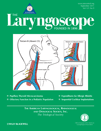Sinonasal malignancies in children: A 10-year, single-institutional review†‡§¶
This study was presented at the 2010 American Head and Neck Society Annual Meeting, Las Vegas, NV.
There is no grant or external financial support.
The authors have no financial disclosures for this article.
The authors have no conflicts of interest to disclose.
Abstract
Objectives:
Sinonasal malignancies in children are rare, histologically diverse tumors that present diagnostic and management challenges. The purpose of this study is to review the experience of a single cancer center in the management of pediatric sinonasal malignancies.
Study Design:
Retrospective review.
Methods:
Retrospective chart review.
Results:
Forty-four patients were identified. The median age was 12 years (range: 2–17), 54% were female, and the maxillary sinus was the most common primary site. Facial swelling and pain were the most common presenting complaints. Thirty-four patients (76%) in this series had paranasal sinus sarcomas, three patients had esthesioneuroblastomas, and eight patients had carcinomas. The 5-year overall survival, disease-specific survival, and recurrence rate for the entire group was 71%, 81%, and 43%, respectively.
Conclusions:
Pediatric sinonasal malignancies are rare, locally aggressive tumors associated with nonspecific signs and symptoms. Multimodality treatment can result in 5-year overall and disease-specific survival rates of over 70%. A multidisciplinary team approach is essential to optimize outcomes and limit the morbidity of treatment.




